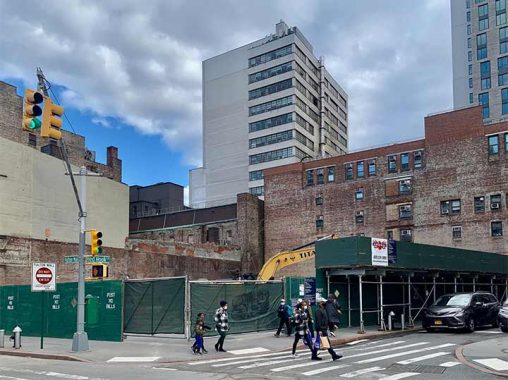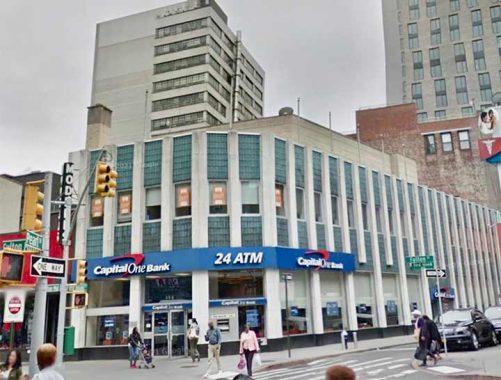
FORGOTTEN Fan Michael Towers was out for a stroll in the Downtown Brooklyn-Brooklyn Heights area when he encountered a recent teardown at the corner of Fulton Street Mall and Red Hook Lane that revealed part of a very old ad at #360 Fulton, with the words DEVELOPING, PRINTING and BROMIDE ENLARGING. The business was once a photo studio that used compounds made with the chemical element bromine:
What is bromide paper? It is simply paper coated with gelatino-bromide of silver emulsion, similar to that which, when coated on glass or other transparent support, forms the familiar dry-plate or film used in negative-making. The emulsion used in making bromide paper, however, is less rapid (less sensitive) than that used in the manufacture of plates or films of ordinary rapidity; hence bromide paper may be manipulated with more abundant light than would be safe with plates. It is used for making prints by contact with a negative in the ordinary printing frame, and as the simplest means for obtaining enlarged prints from small negatives. Sometimes bromide paper is spoken of as a development paper, because the picture-image does not print out during exposure, but requires to be developed, as in negative-making. The preparation of the paper is beyond the skill and equipment of the average photographer, but it may be readily obtained from dealers in photographic supplies.
What are the practical advantages of bromide paper? In the first place, it renders the photographer independent of daylight and weather as far as making prints is concerned. It has excellent “keeping” qualities, i.e., it does not spoil or deteriorate as readily as other printing papers, even when stored without special care or precaution. [Bromide Printing and Enlarging, Tennant and Ward, copyright 1912]

The strange thing is, I was in this very area in March and I did not notice the teardown, so it may have just occurred. The ad in question is on the extreme left of this image.

The building torn down appears to be relatively new but it may have been quite old and was given a modern-looking facade in recent decades. In any case, the bromide ad will be covered up within a few weeks or months. The The figurative use, as in bromide meaning a cliche, is taken from potassium bromide, which was taken as a sedative and was even used during World War I as an anti-aphrodisiac, similar to niter.
All photos: Michael Towers.
As always, “comment…as you see fit.” I earn a small payment when you click on any ad on the site.
4/20/22


2 comments
Let’s see. This is, or was, 356 Fulton Street. There’s going to be a 43-story mixed use tower built there. So much for the future. The building is described here (https://www.brownstoner.com/development/downtown-brooklyn-development-356-370-fulton-street-slce-architects-feil-organization-gage-tollner-skyscraper/) as a “Neo-formalist” building built in 1968 as the HQ for the Equitable Savings and Loan Association, and was designed by Adolf Goldberg.
According to the 1920 edition of the Brooklyn Blue Book, 356-358 Fulton Street was the location of one of the branches of The Mechanics Bank, which merged with the Brooklyn Trust Company in 1929. So when you see a branch of the Brooklyn Trust Company in the 1940 tax maps, or in the pictures of the razing of the Fulton Street El, I believe you’re looking at the building you’re discussing, especially since the 1939-1940 Brooklyn telephone directory lists a Brooklyn Trust Company branch at 356 Fulton. (See, for example: https://1940s.nyc/map/photo/nynyma_rec0040_3_00153_0015#18.04/40.691838/-73.988251 and http://dcmny.org/islandora/object/photosnycbeyond%3A38188/datastream/OBJ/view